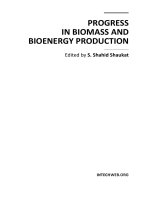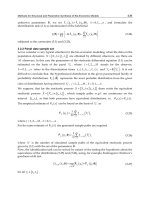Progress in Biomass and Bioenergy Production Part 16 doc
Bạn đang xem bản rút gọn của tài liệu. Xem và tải ngay bản đầy đủ của tài liệu tại đây (277.55 KB, 6 trang )
Methods for Structural and Parametric Synthesis of Bio-Economic Models
439
unknown parameters
θ , we set
() ( )
ˆˆ
:;
kk
Yk Yk
yy= θff, 0,1, ,kn= , and formulate the
identification task (3.1) as minimization of the functional
()
() ()
∈Θ
=
=− −
0
0
1
ˆˆ
inf ln ; ;
k
n
YYk
k
Jyy
θ
θθθff (3.24)
subjected to the constraints (3.1) and (3.23).
3.2.2 Panel data sample set
Let us consider a very typical situation for the bio-economic modeling, when the data on the
population dynamics
[
]
{
}
01
,,
t
XXttt=∈ are obtained by different observers, say there are
M
observers. In this case the parameters of the stochastic differential equation (3.1) can be
estimated on the basis of the panel
j
k
Y , where 1,2, ,jM= stands for the observer,
0,1, ,
kn= refers to the discretization times
001 1
, , ,
n
tt
ττ τ
≤≤
and
00
j
YY
=
E . It is not
difficult to conclude that the hypothesized distribution in the given parametrized family of
probability distributions
()
ˆ
,
X
⋅ θF represents the most probable distribution from the given
class of distributions having observed
j
k
Y , 1,2, ,jM= , 0,1, ,kn= .
We suppose, that for the stochastic process
[
]
{
}
01
,,
t
XXttt=∈
there exists the equivalent
stochastic process
[
]
{
}
01
,,
t
XXttt=∈
, which sample paths w.p.1 are continuous on the
interval
[
]
01
,tt
, so that both processes have equivalent distributions, i.e.
() ()
X
X
xx=
FF
.
The empirical estimate of
()
X
xF can be found on the basis of
j
k
Y
as
()
(
()
,
1
1
k
j
M
j
Yk k
y
j
y
Y
M
−∞
=
=
F1
, (3.25)
where
1,2, ,jM= , 0,1, ,kn= .
For the same estimate of
()
X
x
F
the generated sample paths are required
()
(
]
()
,
1
1
ˆ
;
i
k
N
i
kk
y
Y
i
y
Y
N
−∞
=
=
θ
F1
, (3.26)
where
N is the number of simulated sample paths of the equivalent stochastic process
given by (3.1) with the set of the parameters
θ .
Now, the identification task can be solved by means of the testing the hypothesis about the
equivalence of the distributions (3.25) and (3.26), using, for example, Kolmogorov-Smirnov’s
goodness-of-fit test
()
() ( )
,
,
ˆˆ
;sup ;
k
k
NM k Y k k
Y
yy
Dyy
τ
∈
=−θθ
R
F-F
(3.27)
for all
[
]
01
,
k
tt
τ
∈ .
Progress in Biomass and Bioenergy Production
440
The statistic (3.27) has asymptotic null distribution
()
()
()
*
,
,
; lim ;
kNMk
NM
NM
KS D D D
NM
ττ
→∞
=≤
+
θθp
, (3.28)
where
*
D is critical value of Kolmogorov’s distribution.
The expression (3.28) can be presented also by
()
()
() ( )
12
2
1
;121exp2 ;
kk
KS D D
ττ
+∞
−
=
=− − −
θθ
. (3.29)
A large value of
()
;
k
D
τ
θ
, and therefore a small value
()
()
;
k
KS D
τ
θ , indicates that the
distributions are not equivalent, whereas small values of
()
;
k
D
τ
θ support that the
distributions are equivalent. This fact can be used for the formulation of the identification
task for (3.1), that is to say one has to maximize the functional
() ( )
()
τ
∈Θ
=
=
0
sup ;
n
k
k
JKSD
θ
θθ
(3.30)
subjected to (3.1) and (3.23).
4. Identification method for the time-varying parameters
4.1 Basic assumptions
Let
()
≥
Ω
0
,,{},
tt
PFF be a complete probability space on which some m - dimensional
stochastic process
()
[]
{
}
12
01
, , , , , ,
m
ttt t
BB B t tt=∈
T
BB= is defined such that
0
{}
tt≥
F is the
natural filtration generated by
()
⋅B , augmented by all the P -null sets in F . We suppose
that these stochastic processes are independent and replace (2.6) by the following SDE
() () ()
()
() ()
()
,, ,,dt t t tdt t t td=+θθXaX bX B
,
()
00
d
t =∈XXR ,
[
]
01
,ttt∈ , (4.1)
where
[
]
01
:,
dd
tt××Θ→a RR and
[
]
01
:,
ddm
tt
×
××Θ→b RR with Θ being a given metric
space, which specifies the set of allowable values for the parameters θ ,
()
⋅θ
is the unknown
non-random vector of parameters.
The goal is to present the estimation method for the parameters
()
⋅θ taking into account
some properties of the stochastic process, which is assumed to be the unique strong
solution of (4.1). For the simplicity in further reasoning we will consider one-dimensional
case ( 1dm==) of the SDE (4.1) and limit the family of stochastic processes
()
⋅B to
one-dimensional ordinary Brownian motion (fBm). This gives the possibility to rewrite
(4.1) as
() () ()
()
() ()
()
()
,, ,,dX t a t X t t dt b t X t t dB t=+θθ
,
()
[
]
00 01
,,Xt X t t t=∈ ∈R
, (4.2)
Methods for Structural and Parametric Synthesis of Bio-Economic Models
441
We point out that although the SDE (4.2) is now assumed to be one-dimensional, results can
be extended to m -dimensional case of the SDE (4.1) with the same ideas.
4.2 Estimation principle
There are many possibilities to solve the general optimal control problem (1.1), (1.3) -
(1.6), (4.2) with respect to the identification problem of the parameters θ . Since the
solution of the object equation (4.2) is a stochastic process, it is reasonable to use stochastic
principles as it was done in [Hu at al., 2003]. However, in our case we are not going to
solve "pure" optimal control task, because we consider a non-random vector of
parameters and thus SDE (4.2) can be converted to an ordinary differential equation
(ODE) by means of moment equations.
Let
() ()
1
mt Xt=
E and
() ()
2
2
mt Xt
=
E be the first and second moments of stochastic
process
()
Xt
,
[
]
01
,ttt∈
, generated by the SDE (4.2). Denote a new state variable
() () ()
2
12
,tmtmt= ∈
y
R
,
where
() () ()
01020
,tmtmt=
y (
()
0
10 t
mt X
=
E ,
()
2
0
20 t
mt X
=
E ), and describe object
dynamics using a system of the ODEs
() () ()
()
,,dt t t tdt
ϕ
θyy= a.e.
[
]
01
,ttt∈ . (4.3)
In this manner we have the possibility to use the principle maximum in a form, described in
[Milyutin & Osmolovskii, 1998] or [Milyutin at al., 2004], to solve the parameter estimation
problem. Now we introduce several definitions, which help to construct the estimation
method.
Definition 4.1. Any
()
⋅θ is called a feasible parameters vector
()
f
⋅θ , if
-
()
[
]
01
,tt⋅∈θ V , where
[] []
()
{
}
01 01
, : , is measurablett tt →Θ ⋅θθV ;
-
()
⋅y
is the unique solution of the system of the ODEs (4.3) under
()
⋅θ
;
- the state constraints (1.3) and (1.4) are satisfied;
-
() ()
()
,,
f
tt tθy belongs to the set of Lebesgue measurable functions such that
() ()
()
1
0
,,
t
t
ft t t dt<∞
θy
. ■
Definition 4.2.
()
ˆ
⋅
θ is called an optimal estimate of
()
⋅θ , if
() ()
()
ˆ
ˆ
,⋅⋅
y θJ is measurable
and there exists 0
ε
> such that for any
()
f
⋅u the following inequalities are fulfilled
() ()
[]
()
2
01
,,
ˆ
tt
ε
⋅− ⋅ <yy
C R
,
() ()
()
() ()
()
ˆ
ˆ
,,⋅⋅≥ ⋅⋅
θ y θyJJ
,
Progress in Biomass and Bioenergy Production
442
where
[
]
()
2
01
,,ttC R is the set of all continuous functions,
ˆ
⋅
denotes the estimate.
The definitions (4.1) and (4.2) allow us to propose the goal function (goal) as follows
() ()
()
() ()
()
1
0
,inf,,
t
t
f
tt tdt
∈Θ
⋅⋅=
θ
θθyyJ
where
() ()
()
()
()
2
2
ˆ
ˆ
,, ,, ,,ft t t t t
ϕϕ
=−θθy θyy
and
()
inf ⋅ is the greatest lower bound. ■
The phase constraints (1.3) and state constraints (1.4) can be defined on the basis of the
properties of the stochastic process [Shyryaev, 1998]. As it was said before the Pontryagin’s
type maximum principle will be used to find the solution to the estimation problem. In this
case we introduce the Pontryagin’s function
() () ()
()
() () ()
()
() ()
()
0
,,, ,, ,,ttt t tttt fttt
ψψϕ α
=−θθθH yyy,
where
()
()
2
't
ψ
∈ R is an adjoint function of bounded variation (
[
]
2
01
:,tt
ψ
→ R is an
absolutely continues function),
0
α
is a number.
The theorem below, based on Dubovitski-Milyutin method [Milyutin at al., 2004], gives the
possibility to find an optimal estimate
()
ˆ
⋅
θ of
()
⋅θ for SDE (4.2).
Theorem 4.1. Let
()
ˆ
⋅
θ be an optimal estimate of
()
⋅θ
and
()
ˆ
ˆ
(), ()⋅⋅
y θ be an optimal pair
(
[
]
()
2
01
() , ,tt
∞
⋅∈θ L R ,
[
]
()
2
01
() , ,tt⋅∈y C R ). Then there exist a number
0
α
, a function of
bounded variation
()t
ψ
(which defines the measure d
ψ
), a function of bounded variation
()t
λ
(which defines the measure d
λ
) such that the following conditions hold:
-
nontriviality
0
|| 0d
αλ
+>,
-
nonnegativity
0
0
α
≥ , 0d
λ
≥ ,
-
complementary slackness ()(, ()) 0dtgt t
λ
=y ,
-
adjoint equation
() () () ()
()
() ()
()
()
()
0
ˆˆ
ˆˆˆ
,, ,, ,dt t t t t ft t t gt td
ϕ
αλ
−= − −y θ y θ y
yyy
ψψ
,
-
transversality condition
1
() 0t =
ψ
,
-
the local maximum condition
() () ()
()
() ()
()
ˆˆ
ˆˆ
,, ,, 0ttttfttt
ψϕ
−=
θθ
y θ y θ .
■
The proof of the theorem 4.1 is not complicated and can be found in [Milyutin &
Osmolovskii, 1998].
Methods for Structural and Parametric Synthesis of Bio-Economic Models
443
5. Conclusions
The stochastic differential equation was considered as the bio-economic model in the task of
optimal control of the resource management. Several groups of the parameter estimation
methods for the different types of the stochastic differential equation were proposed. First
group of the estimation procedures is based on the maximum likelihood method, second
one uses principles of Monte Carlo simulations and the last one employs the Pontryagin’s
type maximum principle. First and second group are very sensitive to the structural
selection of the stochastic differential equation, not useful in the case of time-varying
parameters or system of stochastic differential equations. However, they can be used for the
“first iteration” in the time-varying case. The last method can be easily applied for the
mentioned problems. Its scheme, formulated as the theorem, can be used if one is interested
in the parametric identification of a system of the ordinary differential equations. In future,
the numerical experiments are intended to take place in order to investigate the accuracy of
the method.
6. References
Bastogne T.; Thomassin M. & Masse J. 2007. Selection and identification of physical
parameters from passive observation. Application to a winding process. Control
Engineering Practice, 15: 1051 - 1061.
Fan J.; Jiang J.; Zhang Ch. & Zhou Z. 2003. Time-dependent diffusion models for term
struture dynamics. Statistica Sinica, 13: 965 - 992.
Hansen J.A. & Penland C. 2007. On stochastic parameter estimation using data assimilation.
Physica D, 230: 88 - 98.
Hu Y.; Øksendal B. & Sulem A. 2003. Optimal consumption and portfolio in a Back Scholes
market driven by fractional Brownian motion: Infinite dimensional analysis,
Quantum Probability and Related Topics, 6 (4): 519 - 536.
Hurn A.S., Lindsay K.A., Martin V.L. 2003. On the efficacy of simulated maximum
likelihood for estimating the parameters of stochastic differential equations. Journal
of Time Series Analysis, 24: 45 - 63.
Jang M J.; Wang J S. & Liu Y C. 2003. Applying differential transformation method to
parameter identification problems. Applied Mathematics and Computation, 139: 491 -
502.
Jazwinski A.H. (2007). Stochastic Processes and Filtering Theory. Dover Publiscations Inc.
McDonald A.D. & Sandal L.K. 1999. Estimating the parameters of stochastic differential
equations using a criterion function based on the Kolmogorov-Smirnov statistic. J.
Statist. Comput. Simul., 64: 235 - 250.
Milyutin A.A. & Osmolovskii N.P. 1998. Calculus of Variations and Optimal Control,
Translations of Mathematical Monographs, volume 180, American Mathematical
Society, Providence.
Milyutin A.A.; Dmitruk A.V. & Osmolovskii N.P. 2004. Maximum Principle in Optimal
Control, Moscow State University, Moscow (in Russian).
Shoji I. & T. Ozaki 1998. Estimation for the nonlinear stochastic differential equations by a
local linearization method, Stochastic Analysis and Applications, 16: 733 - 752, 1998.
Progress in Biomass and Bioenergy Production
444
Shyryaev A.N. (1998). The Basis of Stochastic Financial Mathematics: Facts, Models
(in Russian).









